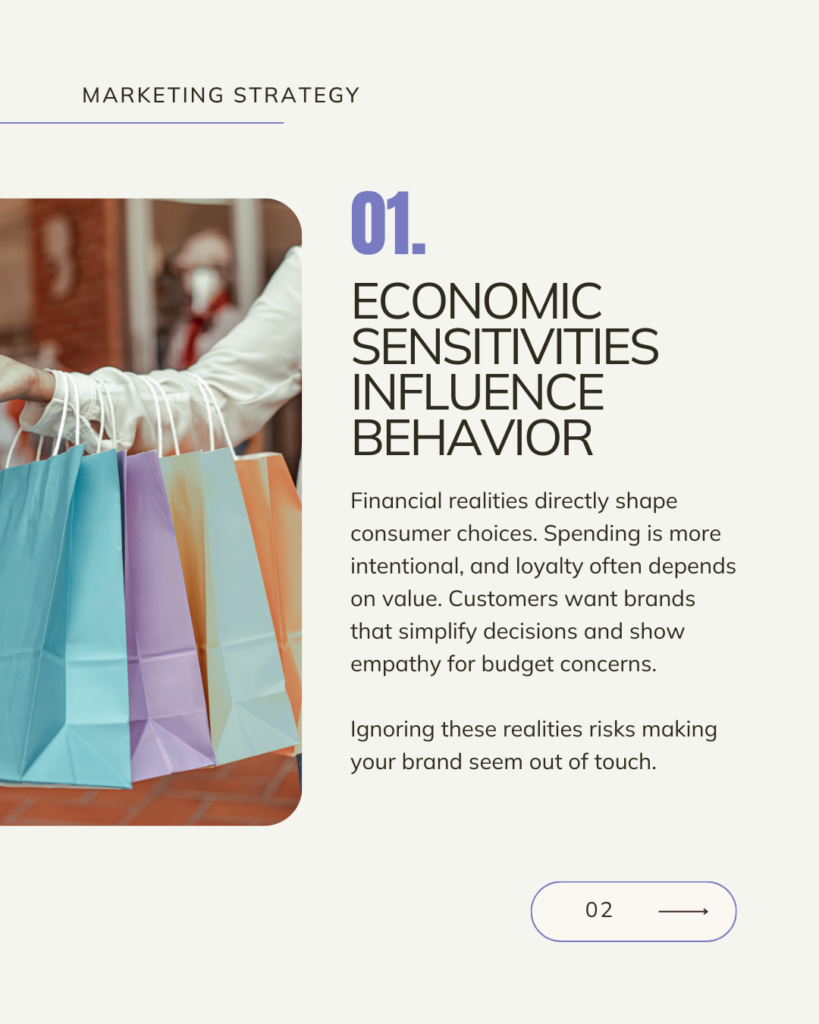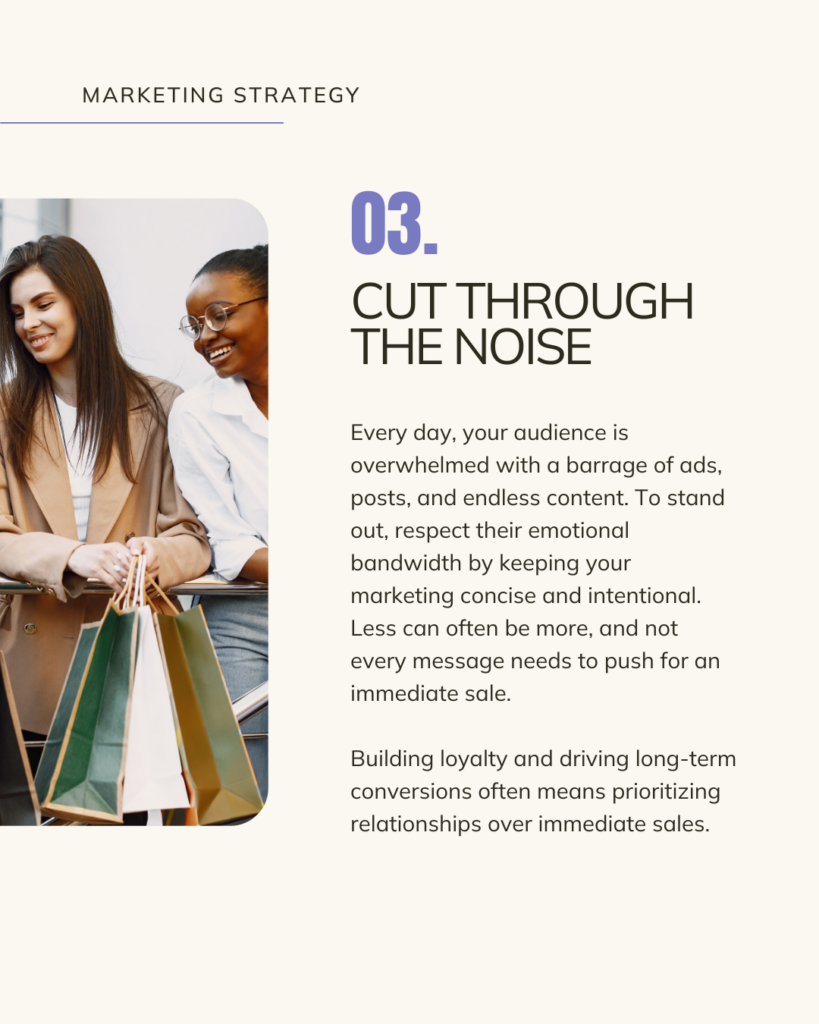WRITTEN BY: CAROLINE REEKIE
The phrase “The world has changed” may be overused, but it rings true. Today’s audiences navigate a complex landscape of economic uncertainty, cultural shifts, and personal challenges. In a world filled with noise, their emotional and financial needs and resources are often stretched to the limit.
For brands, this reality cannot be overlooked. Building meaningful, lasting connections with modern consumers demands a thoughtful and empathetic approach.
Why Emotional and Financial Bandwidth Matter 🤔
1. Economic Sensitivities Influence Behavior
Financial realities directly shape consumer choices. Spending is more intentional, and loyalty often depends on value. Customers want brands that simplify decisions and show empathy for budget concerns.
Ignoring these realities risks making your brand seem out of touch.
2. Cultural Storytelling is Key
Marketing today is about storytelling—connecting your brand to audiences in meaningful ways. To craft stories that resonate, brands need to understand their audience.
Are your consumers worried about the economy? Do they connect with resilience or innovation? By answering these questions and focusing on what matters emotionally, your story stays relevant and engaging.
3. Cut Through the Noise
Every day, your audience is overwhelmed with a barrage of ads, posts, and endless content. To stand out, respect their emotional bandwidth by keeping your marketing concise and intentional. Less can often be more, and not every message needs to push for an immediate sale. Building loyalty and driving long-term conversions often means prioritizing relationships over immediate sales.
THREE KEY EMOTIONAL AND FINANCIAL NEEDS TO ADDRESS



How Brands Can Check the Emotional and Financial Pulse of Their Audience 📈
Leverage Data Wisely
Behavioral data tells a story. Use insights from purchasing habits, social interactions, and trends to understand your audience’s emotional and financial state. Are customers shifting toward budget-friendly options? Engaging more with content on mental health or sustainability? These trends reveal where their priorities lie.
Optimize Your Value Proposition
Regularly evaluate your value proposition against the evolving market dynamics and consumer landscape. Clinging to a “business as usual” mindset or treating your value proposition as a static template risks losing relevancy and can make brands feel out of touch
Integrate Empathy Into Your Messaging
Empathy makes your brand relatable. Acknowledge tough times with thoughtful actions like discounts, pay-later programs, or meaningful narratives. This helps your brand feel more human and less transactional.
The Secret Sauce Recipe 🧑🍳
To succeed in today’s market, brands must go beyond products and services—they need to be present, authentic, and empathetic to build real relationships with their audiences.
Be Present:
Being present isn’t just about trendy TikToks or making headlines. It’s about consistently showing up in your customers’ lives. By understanding their changing needs, brands can adapt and stay relevant. Are you actively listening to your customers? Are your products or services meeting their current expectations? How often do you evaluate and adjust to their evolving priorities?
For example, during the 2008 financial crisis, Starbucks shifted its messaging to focus on value and affordability. The brand introduced initiatives like the Starbucks Rewards program and promoted lower-cost menu options, emphasizing small, everyday indulgences to resonate with customers facing financial challenges. This change in tone and approach helped the brand stay connected to its audience during tough times.
Be Authentic:
Consumers value authenticity, and trust is built when brands reflect their values and deliver on promises. Authenticity isn’t a trend—it’s the key to lasting relationships.
Business leaders, ask yourselves: How are we showing genuine care and understanding for our customers’ current struggles? Are we taking the time to listen to their challenges, adapting our services to meet their needs, and providing real solutions that make their lives easier? Now more than ever, empathy and proactive support matter.
A great example is Patagonia, which has consistently stayed true to its mission of environmental activism. During crises like natural disasters or climate-related events, the brand has stepped up, donating profits to eco-friendly initiatives and advocating for legislation to protect the planet.
Be Empathetic:
Empathy goes beyond data—it’s about connecting with your audience’s challenges and goals. Brands that move from a “they” mindset to a “we” mindset focus on loyalty over quick wins. Thoughtful gestures often resonate most, especially in tough times.
Example: Airbnb showed empathy when it refunded guests and supported hosts during the early days of the Covid 19 pandemic. Despite financial losses, the brand prioritized its community, offering grants to struggling hosts and flexible booking options to travelers.
By embracing presence, authenticity, and empathy, brands like Starbucks, Patagonia, and Airbnb have built emotional bonds that go far beyond transactions.
The question to ask is yourself, colleagues and teams is: how will your brand show up?
Final Thoughts 💭
Understanding your audience’s emotional and financial needs isn’t optional—it’s essential for success in today’s fast-changing world. Navigating this landscape takes empathy, adaptability, and active listening.
The question isn’t whether your brand should evolve—it’s how to do it effectively and authentically. By truly connecting with your audience, you’ll build trust, loyalty, and long-term relevance.
Here’s a thought: If your brand were a person and your customer their friend, how would you show up? Not just with a smile or a discount, but with genuine care, empathy, and purpose. Bring that same intention to your communication, and you’ll earn something far more valuable—your audience’s trust and loyalty.
Want to stay ahead in a shifting consumer landscape? Share your thoughts in the comments or reach out to discuss strategies to help your brand resonate.

BE THE FIRST TO COMMENT: